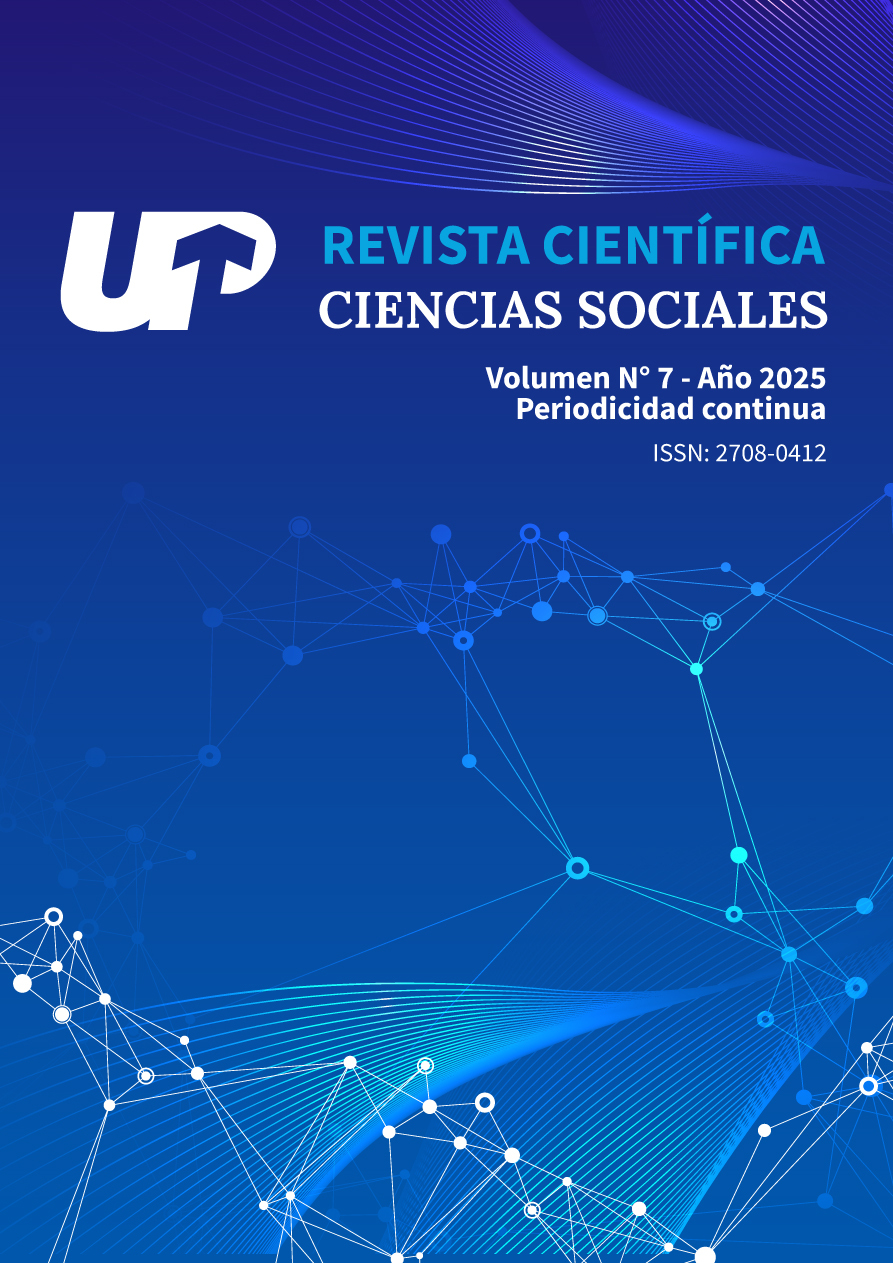Efecto del servicio digital, la seguridad y la experiencia de compra en la satisfacción del cliente del retail de belleza
DOI:
https://doi.org/10.53732/rccsociales/e701121Palabras clave:
Marketing, Digitalización, Tienda virtual, Privacidad de los datos, Consumidor, ComportamientoResumen
Este estudio analiza la interrelación entre los servicios de venta digital, la percepción de seguridad y privacidad, la experiencia de compra virtual y la satisfacción del cliente en el sector minorista de la belleza. Se empleó un enfoque de investigación cuantitativa, utilizando un diseño no experimental, transversal y correlacional-causal. La población objetivo estaba compuesta por 385 residentes del área metropolitana de Lima que compran regularmente productos de belleza a través de plataformas digitales. Se aplicó una técnica de muestreo aleatorio simple, que dio como resultado 377 respuestas, de las cuales 330 se consideraron válidas tras eliminar las entradas incompletas o incoherentes, lo que representa una tasa de respuesta efectiva del 86 %. La recopilación de datos se llevó a cabo mediante un cuestionario estructurado en línea compuesto por 25 ítems, administrado a través de Google Forms y medido utilizando una escala Likert de cinco puntos. Los datos se analizaron utilizando el software SmartPLS 4, aplicando modelos de ecuaciones estructurales (SEM) para evaluar la fiabilidad del constructo, la validez convergente y discriminante, y el poder explicativo del modelo propuesto. La originalidad del estudio radica en su contextualización dentro de un mercado emergente, donde la adopción digital presenta retos específicos. Los resultados indican que los servicios de venta digital influyen positivamente en la percepción de seguridad y en la experiencia de compra virtual, lo que repercute significativamente en la satisfacción general del cliente.
Citas
Aguilar, D., Barrantes, R., Aguero, A., & Soberón, A. (2023). Consumer preferences, perceptions, and persistent barriers: An assessment of internet usage during and post COVID-19 pandemic in Perú. SSRN. http://dx.doi.org/10.2139/ssrn.4527126
Alexander, B., & Blázquez Cano, M.(2020). Store of the future: towards a (re)invention and (re)imagination of physical store space in an omnichannel context. Journal of Retailing and Consumer Services. 55 https://doi.org/10.1016/j.jretconser.2019.101913
Ameen, N., Tarhini, A., Reppel, A. y Anand, A. (2021). Experiencias del cliente en la era de la inteligencia artificial. Computers in Human Behavior, 114, 106548. https://doi.org/10.1016/j.chb.2020.106548
Bakri, Z. (2023). Analyzing the influence of digital marketing strategies on business performance in the beauty industry: A comprehensive analysis of social media engagement and influencer collaborations. Journal on Economics, Management and Business Technology, 2 (1), 37–48. https://plus62.isha.or.id/index.php/JEMBUT/article/view/187
Blázquez, M. (2014). Fashion shopping in multichannel retail: the role of technology in enhancing the customer experience. International Journal Electroic Commerce 18 (4), 97–116. http://dx.doi.org/10.2753/JEC1086-4415180404
Chang, W., & Park, J. (2024). A comparative study on the effect of ChatGPT recommendation and AI recommender systems on the formation of a consideration set. Journal of Retailing and Consumer Services,78. https://doi.org/10.1016/j.jretconser.2024.103743
Chin, W.W. (1998). The partial least squares approach to structural equation modeling. In G. A. Marcoulides (Ed.), Modern methods for business research (pp. 295-336). Mahwah, NJ: Lawrence Erlbaum Associates.
Falk, R.F. & Miller, N.B. (1992). A Primer for Soft Modeling. University of Akron Press.
Fernández, N., Pérez, M., & Vázquez, R. (2018). Webroomers versus showroomers: are they the same? Journal of Business Research, 92, 300–320. https://doi.org/10.1016/j.jbusres.2018.08.004
Frasquet, M., Ieva, M., & Mollá-Descals, A. (2024). Customer inspiration in retailing: The role of perceived novelty and customer loyalty across offline and online channels. Journal of Retailing and Consumer Services, 76. https://doi.org/10.1016/j.jretconser.2023.103592
Gauri, D., Jindal, R., Ratchford, B., Fox, E., Bhatnagar, A., Pandey, A., Navallo, J., Fogarty, J., Carr, S., & Howerton., E. (2021). Evolution of retail formats: Past, present, and future. Journal of Retailing, 97, 42-61.https://doi.org/10.1016/j.jretai.2020.11.002
Grewal, D., Ahlbom, C. P., Beitelspacher, L., Noble, S. M., & Nordf ̈alt, J. (2018). In-store mobile phone use and customer shopping behavior: Evidence from the field. Journal of Marketing, 82(4), 102–126. https://doi.org/10.1509/jm.17.0277
Grewal, D., Hulland, J., Kopalle, P. K., & Karahanna, E. (2020a). The future of technology and marketing: A multidisciplinary perspective. Journal of the Academy of Marketing Science, 48(1), 1–8. https://doi.org/10.1007/s11747-019-00711-4
Grewal, D., Noble, S., Roggeveen, A., & Nordfalt J. (2020b). The future of in-store technology. Journal of the Academy of Marketing Science, 48, 96-113. https://doi.org/10.1007/s11747-019-00697-z
Grewal, D., Roggeveen, A. L., & Nordfa ̈lt, J. (2017). The future of retailing. Journal of Retailing, 93(1), 1–6. https://doi.org/10.1016/j.jretai.2016.12.008
Hair, J. F., Hult, G. T. M., Ringle, C. M., & Sarstedt, M. (2022). A primer on partial least squares structural equation modeling (PLS-SEM) (3rd ed.). Thousand Oaks, CA: Sage.
Hair, J. F., Sarstedt, M., Ringle, C. M., & Gudergan, S. P. (2018). Advanced issues in partial least squares structural equation modeling (PLS-SEM). Thousand Oaks, CA: Sage.
Hossain, T., Akter, S., Kattiyapornpong, U., & Dwivedi, Y. (2019). Multichannel integration quality: A systematic review and agenda for future research. Journal of Retailing and Consumer Services, 49, 154-163. https://doi.org/10.1016/j.jretconser.2019.03.019
Huré, E., Picot-Coupey, K., & Ackermann, C.L. (2017). Understanding omni-channel shopping value: a mixed-method study. Journal of Retailing and Consumer Services, 39, 314–330. https://doi.org/10.1016/j.jretconser.2017.08.011
Kayapinar, Y. (2021). The mediating role of security and privacy on the relationship between customer interface features and e-word of mouth marketing. Turkish Journal of Marketing, 6(2), 125-142. https://doi.org/10.30685/tujom.v6i2.118
Kim, J., Choi, J., Chang, S., & Trivedi, M. (2024). The impact of offline store presence on digital sales: The moderating role of product functionality. Journal of Retailing and Consumer Services, 78. https://doi.org/10.1016/j.jretconser.2024.103754
Lajante, M., Tohib, D., & Ho, T. (2023). When interacting with a service robot is (not) satisfying: The role of customers’ need for social sharing of emotion. Computers in Human Behavior, 146. https://doi.org/10.1016/j.chb.2023.107792
Marinova, D., de Ruyter, K., Huang, M., Meuter, M., & Challagalla, G. (2017). Getting Smart: Learning From Technology-Empowered Frontline Interactions. Journal of Service Research, 20 (1), 29-42. https://doi.org/10.1177/1094670516679273
Martínez Ávila, M. y Fierro Moreno, E. (2018). Aplicación de la técnica PLS-SEM en la gestión del conocimiento: un enfoque técnico práctico. Revista Iberoamericana para la Investigación y el Desarrollo Educativo, 8(16). 130-164. Disponible en: https://doi.org/10.23913/ride.v8i16.336
Molinillo, S., Navarro, A., Anaya, R., & Japutra, A. (2020). The impact of affective and cognitive app experiences on loyalty towards retailers. Journal of Retailing and Consumer Services., 54, 101948. https://doi.org/10.1016/j.jretconser.2019.101948
Mosquera, A., Olarte-Pascual, C., Ayensa, E., & Murillo, Y. (2018). The role of technology in an omnichannel physical store: assessing the moderating effect of gender. Spanish Journal of Marketing – ESIC, 22 (1), 63–82. http://dx.doi.org/10.1108/SJME-03-2018-008
Nguyen, T. T. N. (2020). Developing and validating five-construct model of customer satisfaction in beauty and cosmetic E-commerce. Heliyon, 6(9), e04887. https://doi.org/10.1016/j.heliyon.2020.e04887
Park, E., Jang, Y., Kim, J., Jeong, N.J., Bae, K., & P. del Pobil, A. (2019). Determinants of customer satisfaction with airline services: An analysis of customer feedback big data. Journal of Retailing Consumer Services, 51, 186–190. https://doi.org/10.1016/j.jretconser.2019.06.009
Patro, C. S. (2019). Influence of perceived benefits and risks on consumers’ perceived value in online shopping: an empirical study. International Journal of Applied Behavioral Economics, 8(3), 12–36. http://dx.doi.org/10.4018/IJABE.2019070102
Patro, C. S. (2023). Consumers' digital shopping experience: a study of the factors influencing purchase decision. International Journal of E-Business Research, 19(1), 1-17. 10.4018/ijebr.318475
Ringle, C. M., Wende, S., & Becker, J. M. (2015). SmartPLS 3. SmartPLS GmbH Boenningstedt.
Sharma, P., Ueno, A., Dennis,C., & Turan, C. (2023). Emerging digital technologies and consumer decision-making in retail sector: towards an
integrative conceptual framework. Computers in Human Behavior, 148. https://doi.org/10.1016/j.chb.2023.107913
Vakulenko, Y., Shams, P., Hellström, & D., Hjort, K. (2019). Service innovation in e-commerce last mile delivery: Mapping the e-customer journey. Journal of Business Research, 101, 461-468. https://doi.org/10.1016/j.jbusres.2019.01.016
Wang, M., Marsden, J., Oguz, E., & Thomas, B. (2023). The role of interactive technology in retail design: a case study within the fashion sector. Journal of Marketing Development and Competitiveness, 17(4). https://doi.org/10.33423/jmdc.v17i4.6645
Archivos adicionales
Publicado
Cómo citar
Número
Sección
Licencia
Derechos de autor 2025 Maria Isabel Gil Medina, Julian Alberto Ybarra Poma, Shelby Hubert Ramos Serrano

Esta obra está bajo una licencia internacional Creative Commons Atribución 4.0.



1.png)






















 Todo el contenido de esta revista, está bajo
Todo el contenido de esta revista, está bajo 